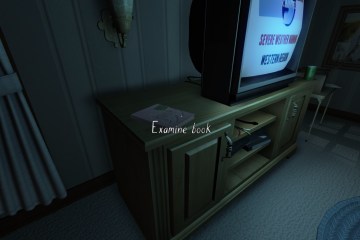We’ve all had that feeling: the uneasiness of being alone in the dark, of being spooked by the sound of our own house settling, of bounding upstairs just a tiny bit faster after we’ve turned off the downstairs lights for the night.
These are sensations that a new PC game called Gone Home manages to recreate, somehow, without the assistance of zombies, monsters or ghosts. Just like in real life, any anxiousness you feel while creeping around your own house in Gone Home is irrational. That doesn’t make it any more comforting when the floorboards creak and the sounds of a thunderstorm rumble in.
Your character is 21-year old Kaitlin Greenbriar, who, after a year traveling abroad, comes home to an empty house that her family has moved into while she was away. Kaitlin’s teenage sister, Samantha, has left a foreboding letter warning not to look for her, yet she has also scattered clues about her disappearance throughout the house. You spend the entirety of the game exploring the grounds, figuring out why no one’s home. (Cleverly, Gone Home is set in 1995, when most folks didn’t own cell phones, and paper was the preferred medium for written communications.)
This requires some suspension of disbelief. Kaitlin seems like a sweet girl, yet she has no qualms peering into her family’s dressers and drawers, reading private letters and learning their secrets. I suppose it’s possible to ignore certain items, but this is a video game after all; exploring every nook and cranny is what we as players do. Gone Home does not judge you for looking.
Without having to shoot or stab anything along the way, it turns out that rummaging for important items in a video game is pretty enjoyable when handled properly. The empty, ever-groaning manor provides the suspense, which you then relieve by systematically moving from room to room, turning on the lights, examining every corner for clues and gradually becoming familiar with your new home. You might even call it therapeutic.

The story, meanwhile, is conveyed through printed pages–letters from friends and colleagues, assignments from work and school, photographs, post-it notes–and through the various rooms of the house, whose scattered belongings tell you just a little more about the people who live there.
It’s a subtle kind of exposition. With the exception of Sam’s audio logs for Kaitlin, no other characters speak throughout the game. Unlike so many other games, they do not catalog their thoughts and feelings in drawn-out diary entries. The story often comes second-hand and in fragments, requiring you to make the connections. In these blank spaces, Gone Home’s story goes to some very dark places, as well as some uplifting ones. Kaitlin herself doesn’t have much to say, and if you discover some of her own letters from around the house, you’ll realize that she’s actually kind of dull. Gone Home isn’t about her.
And, well, I don’t want to get into what Gone Home is about. The best way to experience the game is to have all of its stories–not just Sam’s, but her mother’s and father’s–bubble up naturally as you explore the house. There’s a beautiful arc to the plot, which comes from having certain parts of the house locked off until you find the necessary keys. Gone Home manages to give you some freedom to move, but the narrative stays linear.
My only gripe with the plot is the almost Hollywood-like way in which Sam’s story wraps up. The ending leaves plenty of questions unanswered, but it’s so sugary in execution that it borders on unbelievable–especially given the tone of uncertainty that Gone Home otherwise creates. I feel like some of my emotional response to the game was lost in those final moments.
The entire game takes a few hours, at most, to complete, and while that’s less than the average game, it’s also not a bad thing. The process of plundering each room for clues doesn’t change much from start to finish, and it begins to grow stale just as the story is reaching its conclusion. Gone Home would not have benefited from being a longer game or from changing its mechanics.
The question, then, is whether it’s worth $20. I think so. You could easily burn that kind of cash with a movie ticket and a tub of popcorn. Neither are guaranteed to be as fulfilling.

